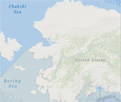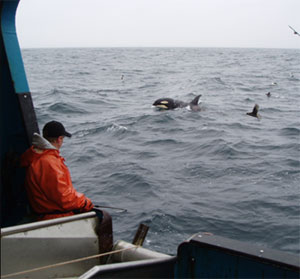 |

Marine Ecology and Stock Assessment
|
Manned submersible Delta. |
| |
|
Adult sablefish. |
| |
The Auke Bay Laboratories’ Marine Ecology and Stock Assessment (MESA) Program is at the center of ABL's two key functions; stock assessment and habitat assessment. MESA supports the NMFS mission and especially NOAA’s Mission Goal: Protect, Restore, and Manage the use of Coastal and Ocean Resources Through an Ecosystem Approach to Management. In addition, MESA research supports the first objective under NOAA’s Climate Goal: Understand and predict the consequences of climate variability and change on marine ecosystems. A thorough description of current activities is found in the 2009 annual report to the Technical Subcommittee of the US- Canada Groundfish Committee (TSC). Primary MESA program functions are:
Stock assessment: Provides information needed by NOAA Fisheries and the North Pacific Fishery Management Council (NPFMC) to manage the Alaska groundfish resource. Scientists use advanced population modeling techniques to integrate biological observations and theoretical considerations into stock assessments that recommend annual groundfish quotas. These are in turn used by the NPFMC to manage fisheries within the U.S. Exclusive Economic Zone (EEZ) of Alaska. Active research to improve management recommendations includes the use of oceanographic, energetic, and satellite data to improve recruitment predictions, genetic stock structure of rockfish, and early life history studies on sablefish, pollock, sharks, rockfish, and salmon.
|
Northern rockfish in Aleutian corals. |
| |
|
Scientist at work. |
| |
| |
Surveys and field studies: Includes the annual longline survey and a wide variety of special at-sea studies. (Follow this link for the most recent longline survey calendar with dates and locations.) The Alaska longline survey assesses groundfish on the continental slope of Alaska. Stock status information is collected for a number of important groundfish species, particularly sablefish, rockfish, and grenadiers. Special projects and extensive tagging of sablefish, thornyhead rockfish, Greenland turbot, and lingcod are integral functions of the survey. The extensive tagging program on the longline survey has provided a wealth of life history information, including migration and exploitation rate estimates, and diel movement patterns. Collaborations with marine mammal scientists are focusing on fishery interactions with marine mammals, such as sperm whale longline depredation of sablefish.
Marine ecology research: Focuses on pelagic, benthic, and estuarine fish habitat; deep sea corals/sponges; and commercial and forage species, to improve stock assessment parameters and to protect and define essential fish habitat (EFH). Through the use of manned submersibles and towed cameras, MESA scientists have identified habitat associations of fish species, discovered extensive coral gardens in the Aleutian Islands, and provided insights into the catchability of trawl gear for groundfish species.High resolution multibeam sonar data have been processed to generate benthic habitat maps of fishing grounds in the Gulf of Alaska and the Aleutian distribution of cold water coral habitat. Analysis of near-shore and estuarine EFH provides information on juvenile groundfish and salmon. Future studies will contrast regions of the Gulf of Alaska and characterize a critical environmental window that fish must pass through during their first year of life as they cross from offshore spawning to nearshore settlement areas.
MESA Program Manager:
Phillip Rigby
Auke Bay Laboratories
Alaska Fisheries Science Center, NOAA Fisheries
Ted Stevens Marine Research Institute
17109 Pt Lena Loop Rd
Juneau, AK 99801
(907) 789–6653
Phillip.Rigby@noaa.gov
News and Research Highlights
 |
Includes dates and locations for the 2015 AFSC Longline Survey. |
 |
Summaries of the annual AFSC Longline Survey catch and abundance data are now easily accessible via the web. Learn more by clicking on the link above. |
 |
Watch this video to learn more about the daily activities and long term uses of the annual AFSC longline survey. |
Featured Research, Publications, Posters, Reports, and Activities
- KELLER, K., K. BROWN, S. ATKINSON, and R. STONE. 2017. Guide for identifying select bivalve species common to southeast Alaska. U.S. Dep. Commer., NOAA Tech. Memo. NMFS-AFSC-341, 25 p.
Online.
- STONE R. P., MALECHA P. W., and MASUDA M. M.
2017. A five-year, in situ growth study on shallow-water populations of the gorgonian octocoral Calcigorgia spiculifera in the Gulf of Alaska. PLoS ONE 12(1):e0169470. http://dx.doi.org/:10.1371/ journal.pone.0169470
Online.
- VEGA, S. L., T. M. SUTTON, and J. M. MURPHY.
2017. Marine-entry timing and growth rates of juvenile chum salmon in Alaskan waters of the Chukchi and northern Bering seas. Deep-Sea Res. II 135:137-144. http://dx.doi.org/10.1016/j.dsr2.2016.02.002
Online.
- De ROBERTIS, A., TAYLOR, K., WILSON, C., and FARLEY, E. 2017. Abundance and distribution of Arctic cod (Boreogadus saida) and other pelagic fishes over the U.S. Continental Shelf of the Northern Bering and Chukchi Seas. Deep-Sea Res. II, 135:51-65. http://dx.doi.org/10.1016/j.dsr2.2016.03.002 Online.
- RODGVELLER, C. J., C. A. TRIBUZIO, P. W. MALECHA, and C. R. LUNSFORD.
2017. Feasibility of using pop-up satellite archival tags (PSATs) to monitor vertical movement of a Sebastes: a case study. Fish. Res. 187:96-102. http://dx.doi.org/10.1016/j.fishres.2016.11.012
Online.
- BANAS, N. S., E. F. MØLLER, T. G. NIELSEN, and L. B. EISNER.
2016. Copepod life strategy and population viability in response to prey timing and temperature: Testing a new model across latitude, time, and the size spectrum. Front. Mar. Sci. 3:225. 10.3389/fmars.2016.00225
Online.
- PINCHUK, A. I., and L. B. EISNER.
2016. Spatial heterogeneity in zooplankton summer distribution in the eastern Chukchi Sea in 2012–2013 as a result of large-scale interactions of water masses. Deep Sea Res. II. Early online. http://dx.doi.org/10.1016/j.dsr2.2016.11.003
Online.
- WATSON J. T., and A. C. HAYNIE.
2016. Using vessel monitoring system data to identify and characterize trips made by fishing vessels in the United States North Pacific. PLoS ONE 11(10): e0165173. http://dx.doi.org/10.1371/journal.pone.0165173
Online.
- MURPHY, J. M., K. G. HOWARD, J. C. GANN, K. C. CIECIEL, W. D. TEMPLIN, and C. M. GUTHRIE III.
Juvenile Chinook salmon abundance in the northern Bering Sea: Implications for future returns and fisheries in the Yukon River. Deep Sea Res. II . Early online. http://dx.doi.org/10.1016/j.dsr2.2016.06.002
Online.
- THORSON, J. T., A. RINDORF, J. GAO, D. H. HANSELMAN, H. WINKER.
2016. Density-dependent changes in effective area occupied for sea-bottom-associated marine fishes. Proc. R. Soc. B 283: 20161853. http://dx.doi.org/10.1098/rspb.2016.1853 Online.
- Exploration of Potential Early Life Mortality in Canadian-Origin Chinook Salmon Eggs due to Thiamine Deficiency
By: C. FUGATE, S. LARSON, K. HOWARD, D. HONEYFIELD, J. MURPHY
Conference: Comparative Nutrition Society 2016 Symposium, Rio Grande, Puerto Rico, Aug 2016
(2016 poster, .pdf, 2.21 MB) Online.
- Spawning Omission and the Productivity Deepwater Rockfish in the North Pacific Ocean
By: CHRISTINA CONRATH, PETE HULSON
Conference: American Fisheries Society, 145th Annual Meeting, Portland, OR, Aug 2015
(2015 poster, .pdf, 3.75 MB) Online.
See the publications and poster databases for additional listings.
To view and print these documents, you must install
Adobe Acrobat Reader
freeware. Adobe also offers
free tools
for the visually disabled
|
 |